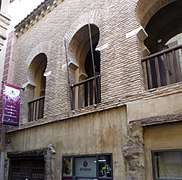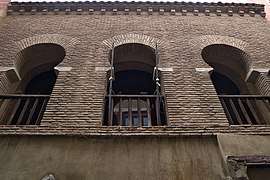Mosque of las Tornerías
The Mezquita de las Tornerías (Arabic: al-Mustimim) is a Moorish former mosque in Toledo (Castile-La Mancha, Spain). It was built in the middle of the 11th century,[1] built on a foundations of Roman architecture, located in the old Muslim neighborhood Arrabal de Francos. Currently it houses the "Center Foundation of Promotion of the Crafts", that can be visited and attend temporary exhibitions. The building continued maintaining the Islam in Spain, even well beyond the reconquista of the city by the Christian troops of Alfonso VI of León and Castile in 1085, until the period of 1498 - 1505 when was desacralizated by the Catholic Monarchs. Already as a building for civil use, it goes through various vicissitudes, first as an inn in 1505 and then as the headquarters of different businesses and small factories or as a simple home. Its history is lost until the late 19th century, where historians investigate its origins didn't know if it was a synagogue or a mosque. After the studies, the 15 March of 1905 was officially communicated to the Real Academia de la Historia the finding of an Arab mosque in the street of the Tornerías.
Features
The mosque was built on the walls of Roman drinking water tanks for distribution of drinking water throughout the city. The great unevenness of the terrain makes possible its layout in two floors which makes it unique. The ground floor, which is accessed from the street of the Tornerías, opens to the Roman deposits with arches of granite of half point. The upper floor, houses the place of worship, retaining remains of the mihrab and the wall of the qibla.
Its construction was made based in one of the main mosques that were in the city of Toledo, the one of the Mosque of Cristo de la Luz or of Bab al-Mardum, of the 10th century. Its plant is irregular square and the interior spaces are organized like that one in nine compartments of square plant, covered with vaticulous domes of brick, except the central one, with special relevance in its ribbed dome. It has horseshoe arches on low columns with large capitals.
Dating
Historians can not agree on its date of construction. can be in the second half of the 11th century, or in the second half of the 12th century.[2]
Gallery
.jpg) Arches in former prayer hall
Arches in former prayer hall.jpg)
.jpg)

.jpg)
.jpg) Horseshoe arches inside prayer room
Horseshoe arches inside prayer room.jpg) Roof
Roof.jpg)
 Top floor exterior
Top floor exterior.jpg) Restoration work
Restoration work.jpg)
.jpg)
.jpg)
See also
Notes
- ↑ Catilla-La Mancha, Descubre e Sciente
- ↑ Markus Hattstein and Peter Delius (Editors) (2007). Islam. Art and architecture. Tandem Verlag. p. 229. ISBN 978-3-8331-3536-1.
References
- Francoise de Montêquin, Compendium of Hispano-Islamic Art and Architecture, St. Paul: Hamline University Press, 1976, ISBN B0006CR5E6, p. 209-210.
External links
- Archnet
- (type "Tornerias" in the Buscar-window Images on Banco de imágines e sonidos )
- Foundation Mosque of the Tornerías. Panoramic photographs can be viewed.]
- La Mezquita de Tornerías in Toledo olvidado.

